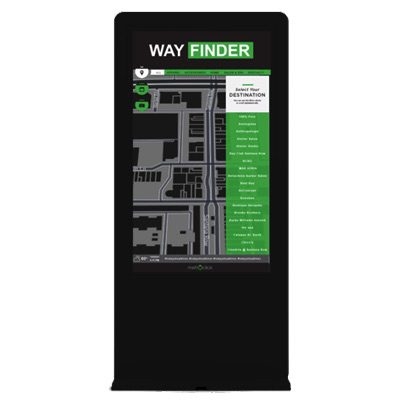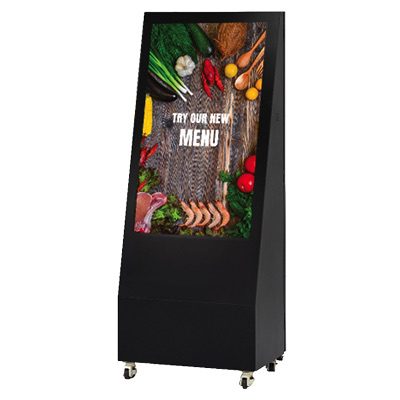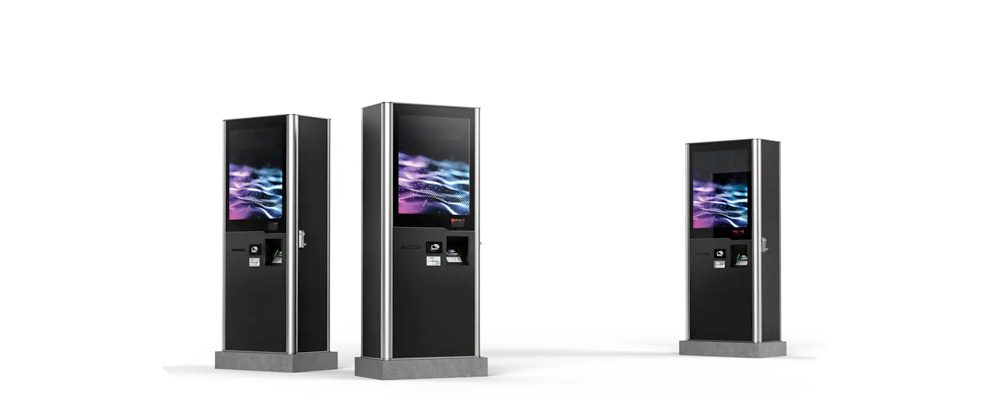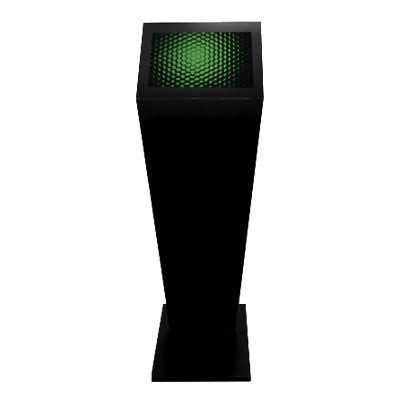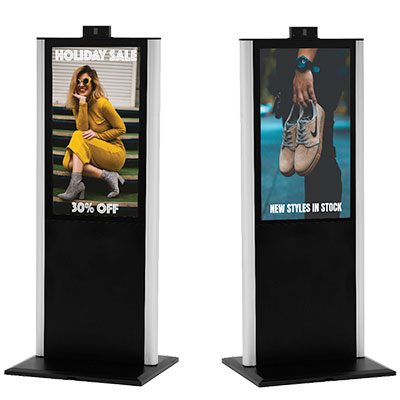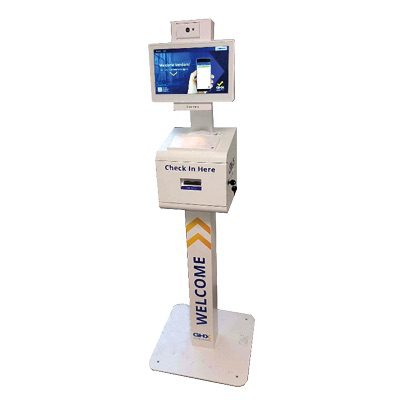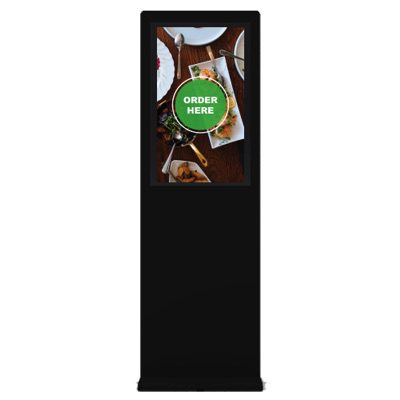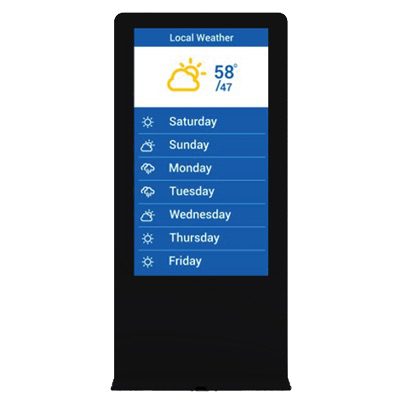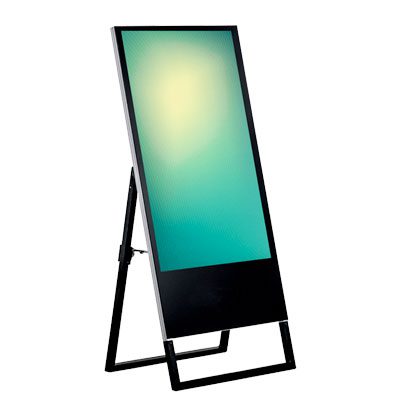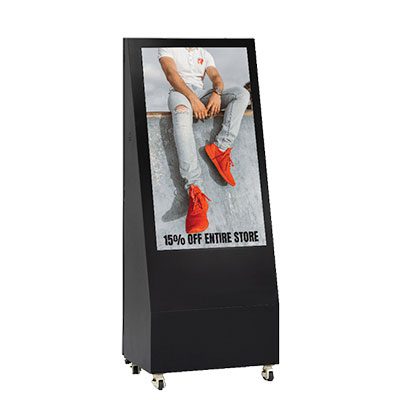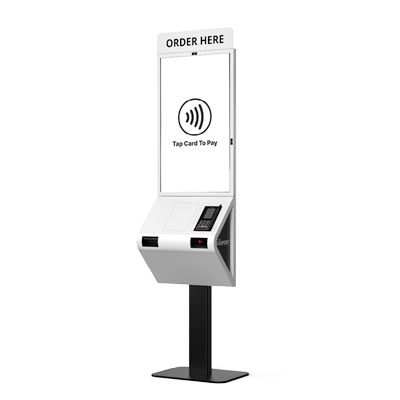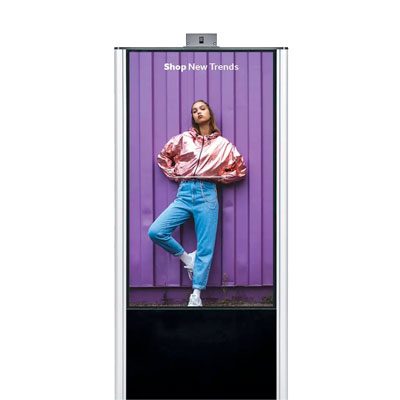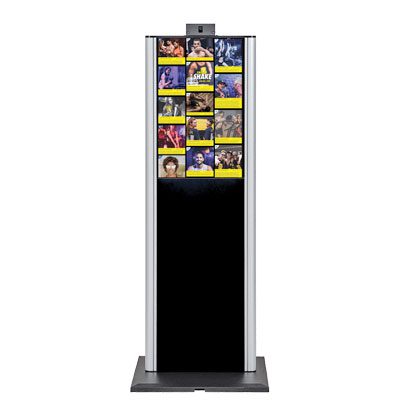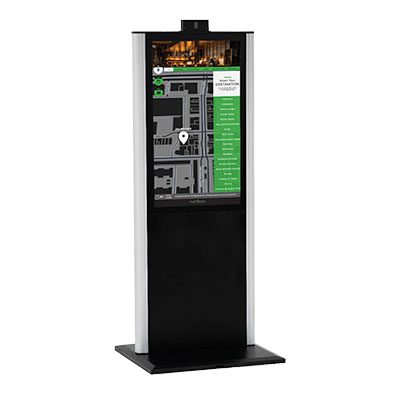Our Kiosk Company Solutions
MetroClick Is One Of The Leading Digital Kiosk Manufacturers In The USA
MetroClick touchscreen kiosks and monitors offer cutting edge retail kiosk and event kiosk technology, allowing your business to keep up with the increased demand for self-service and accurate information.
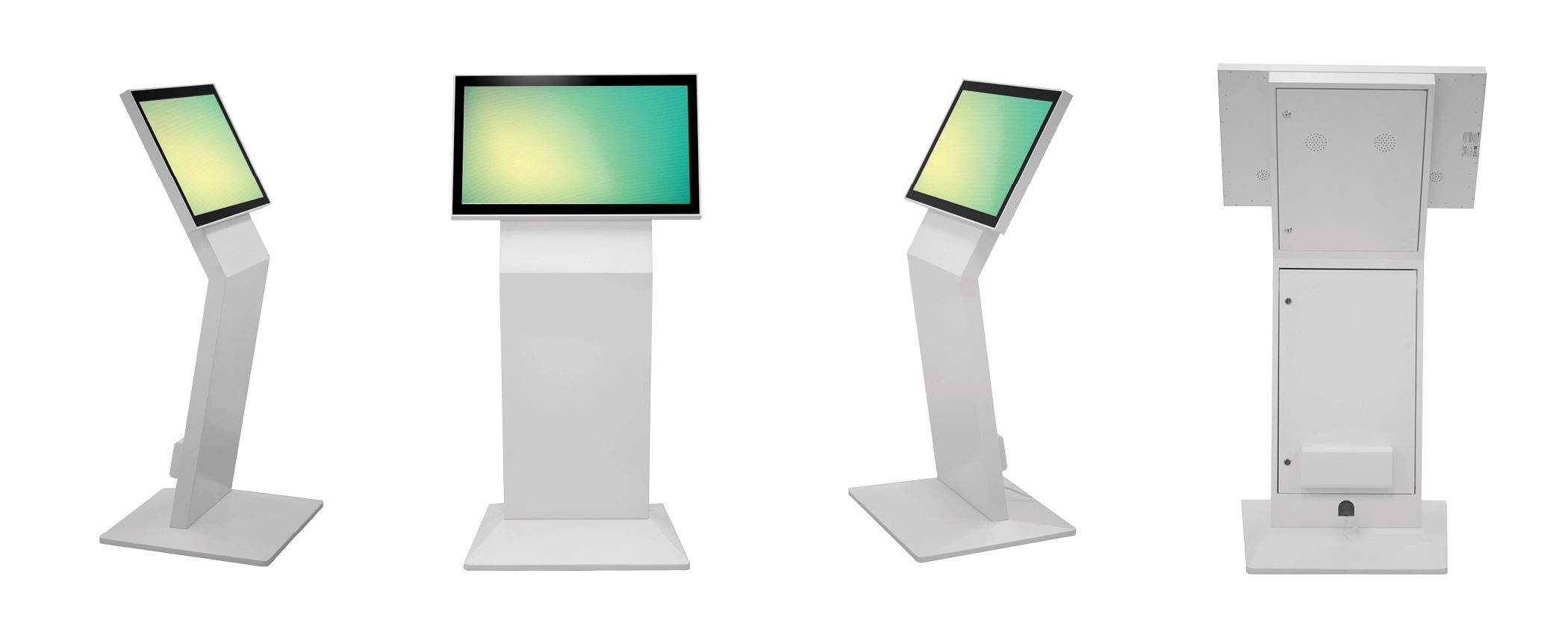
Explore Our Interactive Kiosk Solutions
Empower your customers and streamline your business operations with MetroClick’s innovative self-service kiosk solutions. Our state-of-the-art touchscreen kiosks and monitors are designed to provide cutting-edge technology for retail and event environments, allowing your business to keep up with the growing demand for accurate, efficient, and user-friendly self-service options.
The Power of MetroClick’s Digital Signage Kiosk Technology
With MetroClick’s kiosks with touch screens, you can provide your customers with a seamless experience, allowing them to browse products, place orders, make payments, and access information at their own pace, while freeing up your staff to focus on other tasks. Our customizable kiosk solutions can be tailored to meet the specific needs of your business, and our expert team will work with you every step of the way to ensure a smooth and successful implementation.
Don’t let your business fall behind the competition – take advantage of the benefits of self-service technology today with MetroClick. Contact us now to learn more and schedule a consultation.
More Information
Engage Your Clients With a Proven Kiosk Manufacturer USA
MetroClick, a USA kiosk company, engage clients by inviting them to interactively learn about the information, services, or products your establishment offers via a monitor screen. Catering to the growing demand for self-service, our interactive information kiosk, product display kiosk and store display solutions provide users with the ultimate event or consumer experience.
Self-Service Kiosks
Let your customers serve themselves! Our self service kiosk can act as your sales assistant working for you 24/7. Your customers can do their own browsing, shopping and finally make payment via our kiosks that provide an ideal self service solution. Empower your clientele with convenience and efficiency by implementing our digital kiosks with a state-of-the-art self service solution, streamlining their shopping experience and enhancing overall satisfaction.
Kiosk Features
MetroClick touchscreen monitors come as both indoor and outdoor kiosk models.
All our kiosk models can come with the following additional integrations. Camera, scanner, credit card processing, mobile payment integration, NFC, RFID, receipt printing, photo printing, unique QR codes, speakers, and built-in video camera and face-recognition software.
Customizable Kiosk Solutions from Metroclick, Kiosk Companies in USA
MetroClick kiosks can be built as your custom kiosk on both hardware and software to match the esthetic and decor of your venue.
Our standard kiosk display sizes include the following sizes: sizes include 21.5″ Display, 32″ Display, 42″ Touchscreen Display, and 55″ Touchscreen Display.
Portable and User Friendly
Because our portable kiosk are light, and need only a Wi-Fi connection and power outlet to operate, they can be easily taken anywhere.
You can opt for our kiosk rental package for any events, such as photo taking, pop-shops, self help station, wayfinding kiosks or for portable usage.
MetroClick’s Digital Kiosk Systems Vitalize Businesses
Digital kiosk systems are an effective way to boost customer satisfaction and expand your business at low costs. Plus, they offer numerous other advantages like automation and real-time monitoring/updates.
Before designing a kiosk system, it’s essential to take into account your requirements and limitations. Doing this will enable you to choose the ideal software and hardware technologies.
Effortless Interactive User Experience with Our Proprietary Kiosk Solutions
When customers come to your business, they expect an effortless and engaging experience. Digital kiosk systems offer the ideal solution for delivering this ideal scenario.
They can simplify the process of providing customers with information or selling products and services, as well as offering them a convenient way to make payments. This reduces the need for staff presence and shortens waiting times so customers receive services more quickly – ultimately leading to improved satisfaction levels.
Retail, hospitality or entertainment businesses will find that interactive kiosks can enhance customer experiences and boost profits. Not only that, but they’re an effective way to attract new visitors as well as retain existing ones.
In addition to improving customer experience, digital kiosks can be utilized to collect valuable data about how customers utilize them and what they’re searching for. This data is invaluable for business owners as it allows them to better target their advertising campaigns.
It’s essential to ensure the user interface for these kiosks is user-friendly, as making it difficult for someone to complete a transaction or navigate the interface can result in lower conversion rates. It should be noted that ease-of-use is key when considering whether these machines will be successful; this can be accomplished through careful design and development of the user interface. If it’s difficult for users to navigate or complete transactions efficiently, they likely won’t return again.
Therefore, it’s essential to take into account the technology that will be utilized in your kiosk and how it integrates with other elements of the customer journey. Investing in a kiosk that is tailored specifically for your business and its requirements will be the wisest move you can make.
Tailored Digital Kiosks for Your Niche
Are you looking to install a self-service kiosk at your office building, hotel lobby or event location? Digital kiosk systems offer tailored and scalable solutions. They come in various shapes and sizes that can be tailored to fit your specific business requirements.
For instance, they can display product information, advertising messages and public data. Furthermore, they enable payment which simplifies the checkout process and eliminates the need for sales staff to complete transactions manually.
Kiosks are an effective way to reduce wait times in high-traffic places, such as banks and shopping malls. People don’t enjoy standing in long lines, and businesses often lose money from lost revenue due to wasted time due to inactivity.
Digital kiosks offer an effective solution for collecting customer data, which can be utilized to enhance product offerings and marketing tactics. They can track when customers tend to shop, what items they are interested in buying, as well as their purchase history.
Kiosks can be found in a range of industries, such as retail, transportation and healthcare. In retail settings they’re usually used by brands to display product catalogs, announce sales and special offers, enable payments and highlight trending items. Healthcare practices use them for check-in procedures and searching health records for patients. Lastly, transportation kiosks are often found at airports, bus and train stations to help passengers generate tickets, print them off, locate platforms with maps and check in for flights or trains.
Scalable Digital Kiosk Hardware & Software Systems
Digital kiosks offer businesses a cost-effective, flexible solution that enhances operations and customer experiences. By eliminating manual processing of customer requests, businesses save labor costs and free up staff members to focus on other tasks.
No matter if your business is in retail, healthcare, wayfinding or any other sector, interactive kiosks can simplify operations and enhance customer experience. They also collect valuable customer data that can be utilized to enhance product offerings or marketing strategies.
Kiosks are composed of three main elements: hardware, software and peripherals. Together these parts work in sync to guarantee your kiosk functions optimally and can be updated or maintained remotely.
The initial element is software, which creates the look and feel of a kiosk’s user interface as well as functional logic that guides customers through their interactions with the device. Often custom-designed to meet specific business requirements, this component ensures success for your business.
The second component is hardware, such as touchscreens, printers, barcode scanners and more. When selecting a kiosk manufacturer it’s essential to look into their quality assurance processes, warranty coverage and dependable customer service organization. Furthermore, make sure your application is designed with scalability in mind from the outset.
Work with a Reliable Kiosk Vendor in the USA
Digital kiosk systems offer customers and employees a fresh, interactive experience. Not only do they deliver an enjoyable user experience, but they can also help businesses boost their revenue and productivity at the same time.
Touchscreen kiosks are used in a range of environments, such as shopping malls, airports, hospitals, museums and hotels. They’re especially handy for self-ordering orders which helps users save time and boost customer satisfaction levels.
Kiosks are composed of several components and integrations, such as an enclosure for the screen, software running on it, and peripheral devices like cameras, cash dispensers, keypads and printers depending on their use case. All these pieces work together to allow for smooth operations within the kiosk.
One of the most integral components of a digital kiosk system is its software. This acts as the brain of the kiosk and powers all its capabilities.
A crucial component for the success of a digital kiosk is the resilience of its touchscreen display, which must endure constant use in busy locations.
When choosing a kiosk for your enterprise, it is critical to partner with a seasoned supplier who can create a customized solution tailored to your unique needs. An established company in the field will deliver high-quality products at accessible prices.
Growing Global Engagement of Interactive Kiosk Systems
Retail stores, hospitals and airports alike are seeing the rise of digital kiosk systems. These interactive tools enable customer interactions in various ways – such as checking prices, downloading loyalty apps or paying for goods and services – making them increasingly popular.
Kiosks are not only easy to set up and require minimal upkeep. That saves money on technical support services by traveling technicians who can quickly resolve any issues that arise.
Digital kiosks enable the collection of vital shopper data, revealing popular products and typical wait times in your store. This information can be utilized to assess customer satisfaction, determine loyalty card adoption, and more.
Don’t miss out on the opportunity to revolutionize your business and elevate the customer experience. Join the growing number of companies adopting MetroClick’s state-of-the-art digital kiosk solutions.
MetroClick’s cutting-edge kiosks can enhance efficiency, boost profits, and stand out from the competition. Our user-friendly and eco-friendly kiosk systems are tailored to meet your unique needs, ensuring seamless integration into your existing operations.
Take the first step towards transforming your business today. Contact our sales team to learn more about MetroClick’s digital kiosk solutions and how they can help drive your business to new heights.
MetroClick Manufacturers Kiosk: Revolutionizing Customer Interactions with Advanced Digital Kiosk Technology
MetroClick’s , among the best kiosk manufacturers have designed touch screen kiosks that enhance customer engagement and streamline business operations. Our versatile touch screen kiosk solutions cater to a variety of industries, providing a seamless self-service experience that allows customers to access information and services effortlessly.
Our self-service solutions include a wide range of digital kiosks equipped with the latest touch screen technology. These touchscreen kiosks are perfect for environments where interactive displays are essential, such as retail stores, airports, and healthcare facilities. The sleek design and intuitive interface of each touchscreen kiosk make them an ideal choice for businesses looking to modernize their customer interaction points.
MetroClick kiosks are more than just touch screens; they are comprehensive self-service kiosks that integrate advanced content management systems. This integration allows businesses to easily update and manage the content displayed on their kiosks, ensuring that customers always receive the most relevant and up-to-date information. Our content management system simplifies the process of content deployment across multiple kiosks, making it an indispensable tool for businesses with expansive networks.
In addition to traditional applications, our touch screen kiosks serve as effective bill payment terminals, media players, and digital signage platforms. They are particularly effective in high-traffic areas like trade shows, where businesses can showcase their offerings and capture valuable customer data through email addresses and email lists.
Located in the heart of New York City, MetroClick provides cutting-edge kiosk solutions that help businesses reduce labor costs and improve operational efficiency. Our range of kiosk models and hardware options ensures that there is a perfect fit for every business need. Whether you need a touch screen monitor for a retail application or a robust display screen for an information kiosk, MetroClick has the solution.
Invest in MetroClick’s innovative touch screen kiosks today and transform the way your business interacts with customers. Our commitment to quality and customer satisfaction makes us the leading provider of self-service solutions in the industry.
The Future of Digital and Electronic Kiosks
It is estimated that the global digital touchscreen kiosk market, including interactive kiosks and tablet kiosks, is projected to reach a staggering $38.21 billion by 2027. Digital kiosks have revolutionized customer interactions across various industries, offering innovative solutions for businesses seeking enhanced engagement and efficiency.
Digital kiosks, including touch screen displays and interactive signage, are reshaping the way business organizations operate in a digital format. From retail to healthcare, these versatile digital kiosks use cases streamline processes, boost customer satisfaction, and drive revenue growth. With features like cameras, scanners, and secure payment options, digital kiosks cater to diverse needs while ensuring seamless user experiences.
Key Takeaways
-
Actionable Insight: Customize digital kiosks to suit specific needs and enhance user experience.
-
Relevance: Digital kiosks have diverse applications across industries like retail, healthcare, and hospitality, offering improved efficiency and customer engagement.
-
Connection to Audience: Implement digital kiosks with integrated features such as cameras, scanners, and payment options for enhanced functionality.
-
Link to Content: Explore customer testimonials and case studies to see real-world examples of successful digital kiosk implementations.
-
Actionable Insight: Consider the benefits of digital and electronic kiosks, including robust security measures and interactive capabilities.
-
Longevity: Ensure proper implementation and ongoing support for digital kiosks to maximize their effectiveness in various industry settings.
Overview of Digital Kiosks
Digital kiosks are interactive self-service machines that provide information, services, or entertainment to users. They are commonly seen in various public settings like shopping malls, airports, hospitals, museums, and touch screen kiosks. These kiosks utilize touch screen technology for user interaction, making them intuitive and user-friendly.
Benefits of Digital Kiosks for Businesses
-
Versatility: Digital kiosks can be tailored to suit different environments and purposes, offering flexibility in their applications.
-
Touch Screen Technology: The incorporation of touch screens enhances user experience by enabling easy navigation and interaction.
-
Variety of Designs: Businesses can choose from a range of designs to match their branding and fit specific locations seamlessly.
-
Specialized Hardware and Software: The use of specialized components enhances functionality and ensures a smooth user experience.
-
Pre-installed Content Management Systems: These systems make it simple for businesses to update content regularly without technical expertise.
Evolution of Digital and Electronic Kiosks
Setting up digital kiosks has become simpler over time, requiring less complex equipment and technical knowledge. This evolution allows businesses to deploy kiosks swiftly and efficiently. Programming apps directly on the kiosk saves time and enables quick updates without external support.
Kiosks help in reducing operational costs by minimizing the need for additional staff, streamlining processes, and improving efficiency. By engaging customers effectively through interactive features, kiosks have the potential to boost sales and revenue for businesses. Remote content updates ensure that the information displayed remains current and engaging for users.
Types of Digital Kiosks
Indoor Digital Kiosks
Indoor digital kiosks are equipped with multi-point touch screens that enhance user interactions. These kiosks offer personalized experiences tailored to individual customer needs, improving engagement. By displaying dynamic content, they effectively capture customer attention and drive interaction.
Businesses benefit from digital kiosks by enhancing customer satisfaction through self-service options. The competitive advantage gained by leveraging advanced digital solutions sets them apart in the market. Indoor kiosks play a crucial role in streamlining operations and delivering seamless customer experiences.
Indoor environments such as retail stores, hospitals, and airports are ideal for deploying digital kiosks. These settings allow for maximum visibility and accessibility, ensuring that customers can easily interact with the kiosk. The versatility of indoor kiosks makes them valuable assets for businesses looking to enhance customer service and streamline processes.
Outdoor Digital Kiosks
Outdoor digital kiosks feature weather-resistant designs to withstand varying environmental conditions. These robust kiosks are built to endure elements such as rain, snow, and extreme temperatures, ensuring uninterrupted functionality. The durability of outdoor kiosks makes them reliable solutions for outdoor settings.
In outdoor settings like parks, transportation hubs, and outdoor events, digital kiosks serve various use cases. They provide information on schedules, directions, and event details, enhancing visitor experience. Outdoor kiosks also offer interactive maps and wayfinding services to guide users effectively in large outdoor areas.
Portable Digital Kiosks
Portable digital kiosks offer the advantage of mobility, allowing businesses to deploy them in versatile locations. These kiosks can be easily moved to different settings based on changing requirements, providing flexibility in deployment. Portable kiosks are ideal for temporary events, trade shows, or pop-up shops.
Businesses can leverage portable kiosks for diverse applications such as product showcases, registration points, or interactive demos. The flexibility and convenience of portable kiosks make them valuable assets for businesses seeking dynamic customer engagement solutions. Portable kiosks enable businesses to reach a wider audience and enhance brand visibility.
Digital Kiosk Customization
Custom Design Options
Tailoring Kiosks to Specific Needs
Customizing digital kiosks allows tailoring them to specific requirements, ensuring they meet unique functionalities. Businesses can modify digital kiosk design to suit diverse purposes, such as information dissemination or transaction processing. By adapting the digital kiosk interface, companies enhance user experience and streamline operations.
To cater to specific needs, digital kiosk deployments can be personalized with distinct features like barcode scanners for inventory management or ticket printers for event check-ins. This customization ensures that the digital kiosk content aligns with the intended use, maximizing efficiency and user satisfaction. Companies can choose from a variety of sizes, shapes, and materials for their digital kiosks, creating a bespoke solution.
Offering tailored digital kiosks hardware components enables businesses to integrate specialized tools such as biometric readers or NFC technology for secure transactions. These customized elements enhance the functionality of digital kiosks, providing a seamless experience for users across various industries.
Advanced Features and Integrations
Camera, Scanner, and Payment Systems
Integrating advanced features like cameras enables digital kiosks to offer interactive experiences such as virtual try-on for retail or patient check-ins at healthcare facilities. Barcode scanners facilitate quick data entry, while payment systems enable secure transactions directly through the digital kiosk. These components enhance user convenience and operational efficiency.
By incorporating software solutions, businesses can create interactive elements like touch screens and voice commands, enhancing user engagement. These features empower users to navigate through menus, access information, and complete transactions effortlessly. The integration of cutting-edge technologies elevates the overall functionality of digital kiosks, making them versatile tools across industries.
-
Pros:
-
Enhanced user experience
-
Improved operational efficiency
-
Secure transactions
-
-
Cons:
-
Initial customization costs
-
Maintenance requirements
-
Industry Applications of Digital Kiosks
Retail Digital Kiosks
In retail, digital kiosks play a crucial role in enhancing the shopping experience for customers. These kiosks provide quick access to product information, promotions, and discounts. Customers can easily navigate through the store layout and locate items they need.
Retail digital kiosks offer self-service options, allowing customers to check product availability, place orders, and make payments independently. This reduces waiting times at checkout counters and enhances overall customer satisfaction. Moreover, these kiosks provide valuable insights into customer preferences and buying patterns.
Digital kiosks in retail settings serve as interactive tools that engage customers effectively. By offering personalized recommendations based on previous purchases or browsing history, these kiosks enhance the shopping journey. Customers can also access additional product details, reviews, and ratings, empowering them to make informed purchasing decisions.
Hospitality and Entertainment Kiosks
In the hospitality industry, interactive solutions offered by digital kiosks cater to guests’ needs efficiently. Guests can check-in seamlessly, access room service menus, book reservations, and request amenities through user-friendly interfaces. This enhances guest satisfaction and streamlines hotel operations.
Hospitality digital kiosks also serve as digital directories and wayfinding tools within hotels and entertainment venues. Guests can easily navigate complex layouts, locate facilities such as restaurants or event spaces, and access event schedules or promotions. These kiosks improve guest experience by providing relevant information promptly.
Healthcare Digital Kiosks
Healthcare digital kiosks streamline patient check-in processes and provide essential information systems within medical facilities. Patients can update their personal details, verify insurance information, and fill out necessary forms electronically using these kiosks. This reduces administrative burden on staff and minimizes waiting times for patients.
Benefits of Digital and Electronic Kiosks
Improving Customer Engagement
Digital kiosks enhance customer engagement through interactive and user-friendly interfaces. Customers can easily navigate menus, browse products, and access information independently.
Digital kiosks offer personalization options, leading to increased customer satisfaction. By tailoring recommendations and services based on individual preferences, customers feel valued and catered to.
Implementation and Support for Digital Kiosks
Steps to Deploying Digital Kiosks
Planning and Installation Process
To deploy digital kiosks, start by planning the placement and purpose of each kiosk in your space. Then, proceed with the installation process, ensuring power sources and network connectivity are readily available.
When installing digital kiosks, consider factors like foot traffic, visibility, and accessibility. Customize each kiosk to suit its location and intended use, ensuring a seamless integration into your environment.
Customization and Configuration
For successful deployment, customize the interface and content to match your branding and user needs. Configure software settings for optimal performance and user interaction, enhancing the overall experience.
Customizing digital kiosks involves designing user-friendly interfaces with intuitive navigation. Configure software features such as touch screen responsiveness and interactive functionalities for a smooth user experience.
Ongoing Support and Maintenance
Ensuring Optimal Performance
To maintain optimal performance, conduct regular checks on hardware components like screens, cameras, and scanners. Ensure all software features are functioning correctly to provide a seamless user experience.
Regular maintenance includes cleaning touch screens, updating software, and testing all functionalities. By addressing issues promptly, you can ensure digital kiosks operate smoothly at all times.
Regular Updates and Troubleshooting
Keep digital kiosks up-to-date with the latest software updates to enhance security and performance. Implement a regular update schedule to address any software vulnerabilities promptly.
In case of technical issues, have a troubleshooting plan in place to diagnose and resolve problems efficiently. Provide training for staff members to handle common issues effectively.
Customer Testimonials and Case Studies
Success Stories from Various Industries
Digital kiosks have revolutionized multiple industries, showcasing enhanced customer engagement and operational efficiency. In retail settings, kiosks streamline check-out processes, leading to shorter queues and happier customers. Hospitality venues utilize kiosks for self-service check-ins, reducing wait times and improving guest satisfaction.
Healthcare facilities benefit from digital kiosks by providing patients with self-check-in options, minimizing administrative tasks for staff. Educational institutions implement kiosks for student information centers, campus maps, and event registrations. These diverse applications demonstrate the versatility and effectiveness of digital kiosks across different sectors.
Real-Life Applications of Digital Kiosks:
-
Retail: Self-checkout kiosks
-
Hospitality: Self-service check-ins
-
Healthcare: Patient self-check-in
-
Education: Campus information centers
Customer Feedback
Customers praise MetroClick’s digital kiosks for their user-friendly interfaces and seamless interactions. Positive reviews highlight the convenience of self-service options and the speed of transactions. Users appreciate the intuitive design of the touch screen kiosks, making navigation effortless for individuals of all ages.
Reviews and Experiences with MetroClick Digital Kiosks:
-
“The touch screen kiosk at our hotel lobby transformed our check-in process.”
-
“Using MetroClick’s interactive directory made finding stores in the mall so much easier.”
MetroClick’s commitment to innovation and customer satisfaction is evident in the glowing testimonials from various industries. The reliability and functionality of their digital kiosks have garnered widespread acclaim, solidifying MetroClick’s position as a leader in interactive solutions.
Frequently Asked Questions (FAQs)
Common Queries About Digital Kiosks
What Are the Benefits of Digital Kiosks?
Digital kiosks offer enhanced customer engagement through interactive touch screens and personalized experiences. They improve efficiency by reducing wait times and streamlining processes. They provide robust security features to protect user data.
Digital kiosks come with flexible customization options, allowing businesses to tailor the interface to their specific needs. They can be equipped with features like cameras for facial recognition, scanners for QR code scanning, and payment integrations for seamless transactions.
To choose the right digital kiosk for your needs, consider factors such as your industry requirements, the desired functionalities (e.g., self-service check-ins or wayfinding), and the location where the kiosk will be placed. Evaluate the size and design options to ensure it fits seamlessly into your space.
Customization and Integration Questions
What Features Can Be Added to Digital Kiosks?
Digital kiosks can be enhanced with various features, including printers for receipts, NFC capabilities for contactless interactions, and sensors for environmental monitoring. These additional features cater to diverse business needs and enhance user experience.
Integration of digital kiosks with existing systems is crucial for seamless operations. By connecting kiosks to backend systems such as customer databases or inventory management software, businesses can ensure real-time updates and accurate information display on the kiosks.
When integrating digital kiosks with existing systems, businesses should consider factors such as compatibility, data security measures, and the level of automation required. This ensures a smooth transition and efficient operation across all touch points.
Final Remarks
You’ve now explored the diverse world of digital kiosks, from their various types to customization options and industry applications. Understanding the benefits they offer in enhancing customer engagement, improving efficiency, and boosting security is crucial for leveraging their full potential. By delving into customer testimonials and case studies, you’ve witnessed real-world success stories that highlight the impact of digital kiosks across different sectors.
To make the most of these innovative solutions, consider how digital kiosks can revolutionize your business operations. Whether you’re in retail, hospitality, healthcare, or any other industry, integrating digital kiosks can streamline processes and elevate the customer experience. Take the next step towards implementing digital kiosks tailored to your specific needs and witness the transformation they can bring to your organization.
Frequently Asked Questions
What are digital kiosks used for?
Digital kiosks are used for interactive information display, self-service transactions, wayfinding, advertising, and customer engagement in various industries like retail, healthcare, hospitality, and transportation.
How can digital kiosks benefit my business?
Digital kiosks can enhance customer experience, reduce wait times, increase operational efficiency, boost sales, capture data for analytics, provide real-time updates, and promote brand awareness.
Are digital kiosks customizable?
Yes, digital kiosks can be customized to match your brand’s aesthetics, integrate specific software functionalities, offer multiple payment options, include touchless features, and adapt to different use cases.
Do digital kiosks require ongoing support and maintenance?
Yes, digital kiosks need regular maintenance to ensure optimal performance. This includes software updates, content management, hardware checks, remote monitoring for issues, troubleshooting, and technical support for any user queries.
Can digital kiosks be integrated with existing systems?
Digital kiosks can be integrated with existing systems such as POS systems, inventory management software, CRM platforms, wayfinding applications, content management systems (CMS), and other backend operations to streamline processes and data flow.
Advanced Kiosk Technology
Digital kiosks have changed how businesses connect with customers. By using interactive kiosks, brands can share vital information and services in a way that’s easy to use. These kiosks make use of digital signage and touchscreen interfaces to allow real-time communication with consumers, improving their experience and engagement.
Enhancing Customer Experience through Interactive Digital Kiosks
Interactive digital kiosks help make the customer experience better. Here are a few ways they do this:
- Access to Information: Customers can quickly find what they need without having to wait for help.
- User-Friendly Design: Touchscreen interfaces make it simple and fun to navigate.
- Brand Engagement: Kiosks act as a platform to promote the brand while keeping customers engaged interactively.
Latest Innovations in Digital Kiosk Functionality
The features of digital kiosks keep getting better, thanks to new tech ideas:
- Smart Kiosks: These devices provide real-time information and updates to users.
- Multimedia Capabilities: Adding video and interactive displays boosts user interaction.
- Software as a Service (SaaS): Many kiosks work on cloud-based software, making updates easy.
Versatility of Digital Kiosks
Digital kiosks can be used in many different industries, showing their adaptability.
Wide-Ranging Applications of Digital Kiosks across Industries
Digital kiosks are useful in various sectors, such as:
- Retail Kiosks: For giving product info and allowing self-checkout.
- Payment Kiosks: For fast and safe transactions.
- Public Information Kiosks: Providing important data in public areas.
Integration of Digital Kiosks in Retail, Healthcare, and Hospitality
Kiosks are becoming more common in important sectors:
- Retail: Boosting customer engagement by making information available and shopping easier.
- Healthcare: Helping with patient check-ins and sharing health info.
- Hospitality: Making check-in/out smoother and offering local information to guests.
Customizability and Flexibility of Digital Kiosk Solutions
Businesses can customize digital kiosk solutions to meet their needs:
- Customizable Software: Adjust features and functions to align with business goals.
- Flexible Hardware Options: Choose kiosk designs that fit the brand and space.
- Integration Capabilities: Easily link kiosks with existing systems for better operations.
Benefits of Digital Kiosk Adoption
Using digital kiosks brings many benefits that improve both employee and customer satisfaction.
Increased Employee and Customer Satisfaction through Digital Kiosks
Digital kiosks have a positive impact on the workplace:
- Automated Service: Lessens staff workload so they can focus on more detailed tasks.
- User-Friendly Interface: Improves customer satisfaction by speeding up service delivery.
Improved Efficiency and Streamlined Processes with Digital Kiosks
Efficiency is one big benefit of using digital kiosks:
- Streamlined Processes: Simplifies tasks, cutting down wait times for customers.
- Queue Management: Helps organize customer flow, which reduces bottlenecks.
- Remote Management: Allows easy monitoring and updates from anywhere.
Enhancing Brand Image and Customer Loyalty
Investing in digital kiosks can also boost a brand’s reputation:
- Brand Promotion: Use kiosks to advertise and highlight special offers.
- Loyalty Programs: Add features that reward returning customers, helping to build loyalty.
- Community Engagement: Offer local info, which strengthens community trust.
Explore our range of digital kiosk solutions at MetroClick to enhance your customer engagement and streamline operations today!
5. Kiosk Deployment and Management
Deploying digital kiosks takes careful planning and management. Here’s how we can help:
- Kiosk Solutions: We offer various kiosk solutions for different industries, making sure your business needs are met.
- Kiosk Hardware: Our digital kiosk hardware is built to last and easy to use, improving the customer experience.
- Remote Management Kiosk: With our remote management features, you can manage multiple kiosks from one place. You can monitor, update, and fix issues quickly.
- Technical Support: Our friendly technical support team is ready to help you with any problems, so your kiosks stay up and running.
Adding kiosks to your business can help you run things more smoothly and keep your customers happy.
6. User Engagement Techniques
Getting customers engaged with interactive kiosks is key for today’s businesses. Here are some good techniques to try:
- Interactive Displays: Use interactive displays to create fun experiences that attract customers.
- Touchscreen Interface: Make sure your kiosks have a user-friendly touchscreen interface to make it easy for everyone to use.
- Multimedia Content: Add different kinds of content like videos and graphics to grab customer attention and share important info.
- Accessible Kiosk Design: Design your kiosks so everyone, including people with disabilities, can use them easily.
These techniques improve customer experience and encourage people to use your kiosks more often.
7. Data Analytics and Insights
Understanding customer behavior is important for improving your services and boosting sales. Here’s how data analytics can help with kiosks:
- Real-Time Analytics Kiosk: Use real-time analytics to see how customers use your digital kiosks and what they want.
- Data Collection Kiosk: Kiosks can collect valuable data to understand what customers prefer and how they act.
- User-Friendly Kiosk Analytics: Present your data in an easy way so teams can quickly make decisions based on what they learn.
- Digital Transaction Kiosk Monitoring: Keep track of data from digital transactions at kiosks to spot trends and areas for growth.
Using data analytics helps businesses make smarter choices that enhance performance and improve customer satisfaction.
Kiosk Hardware and Software
Choosing the Right Kiosk Hardware for Diverse Environments
Picking the right kiosk hardware is key to making sure it works well and keeps users happy. Here are some simple things to think about:
- Environment: Think about where your kiosk will go, like inside or outside. This will help you choose tough materials that can handle the weather.
- Touch Screen Type: You have options! Resistive screens are okay, but capacitive touch screens are better for fun and quick interactions.
- Security Features: Make sure the kiosk has strong security measures, like special locks and sturdy designs that stop tampering.
- Size and Design: Choose a size that fits where you want it to go. Also, make sure it’s easy for people to see and use.
Investing in good kiosk hardware makes self-service kiosks work better, helping customers and improving business operations.
Tailoring Kiosk Software to Specific Business Needs
Choosing the right kiosk software can really boost how users interact with your system. Here are some points to keep in mind:
- User-Friendly Interface: Pick software that’s easy to use! It should be simple for customers to find what they need and complete their tasks.
- Management Capabilities: Look for software that helps manage data collection easily. This way, you can see how well things are going and what needs fixing.
- Kiosk Integration: Make sure the software works smoothly with other systems you already have, like payment options and inventory tools.
- Software as a Service (SaaS): Consider SaaS for a straightforward setup that gets updated automatically, saving you money upfront.
The right software turns digital kiosks into powerful tools, helping both businesses and customers.
Ensuring Security and Reliability of Digital Kiosk Systems
Keeping your digital kiosk systems secure and reliable is very important. Here are ways to make sure of that:
- Network Security: Use safe connections and encrypt all communications to keep customer data safe from hackers.
- Regular Updates: Always update your software and firmware to close any security gaps.
- Monitoring Tools: Use remote management tools that let you check on your kiosks’ performance and security any time.
- User Authentication: Add ways for users to prove who they are so that only trusted people can access sensitive information.
Making security strong builds trust with customers and helps your kiosks be reliable service points.
Future Trends in Digital Kiosks
Emerging Technologies and Their Impact on Digital Kiosks
Digital kiosks are changing all the time thanks to new tech. Here’s what’s happening now:
- Internet of Things (IoT): Connecting kiosks with other devices gives real-time data and makes interactions smarter.
- Interactive Displays: Modern displays grab user attention with engaging content and touch features.
- Smart Kiosks: These kiosks learn from user actions to create better experiences just for them.
As technology gets better, kiosks will change how businesses engage with customers.
How Artificial Intelligence and Machine Learning Enhance Kiosk Capabilities
AI and machine learning are making kiosks much smarter:
- Customer Experience: AI helps kiosks suggest things to users based on what they like, making their experience better.
- Real-Time Analytics: Machine learning looks at user behavior to help businesses adapt quickly to changes.
- Automated Services: Kiosks can do tricky tasks using AI, which means shorter wait times and smoother service.
Using AI and ML in kiosks boosts interaction and makes operations run more smoothly.
The Role of Digital Kiosks in Smart Cities and Connected Ecosystems
Digital kiosks are vital in building smart cities. They play important roles, such as:
- Community Information Access: Kiosks give people important info about local services and events.
- Communication Hubs: They help share news and alerts with the community effectively.
- Digital Signage: Kiosks show ads and promos, helping local businesses connect with customers.
Through these functions, digital kiosks help improve urban life and community connection.
Contact Us
for Solutions
Have questions? Interested in a quote or RFP? Contact us today and one of our specialists will follow up ASAP!
California
804 Anacapa Street
Santa Barbara, CA 93101
Florida
7630 NW 25th ST
Suite 2A
Miami, FL 33122
Metroclick Offices
T: 646-843-0888
New York
239 West 29th Street
Ground Floor
New York City, NY 10001







